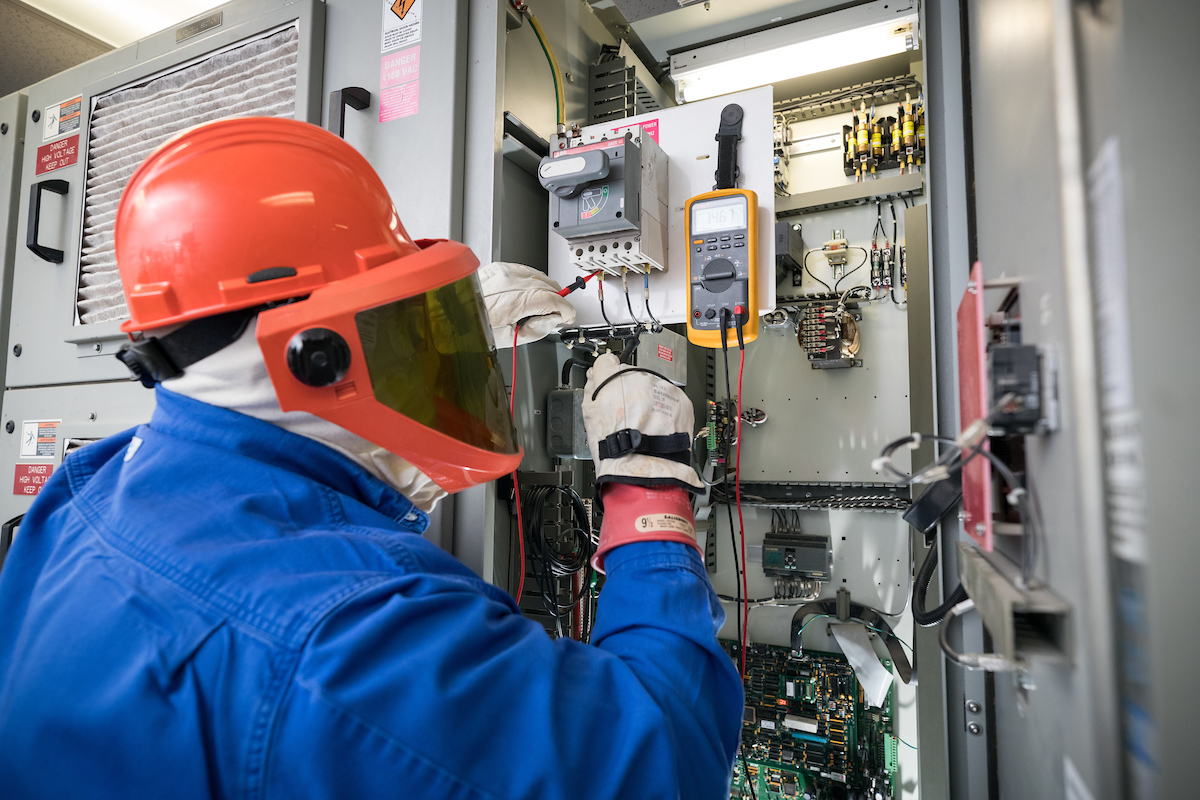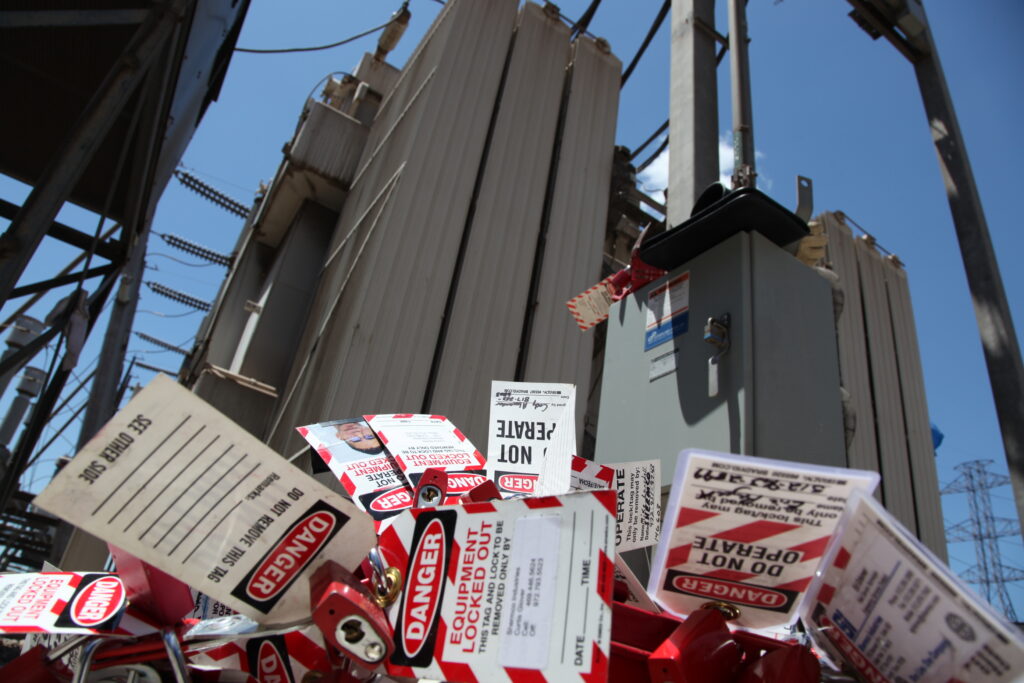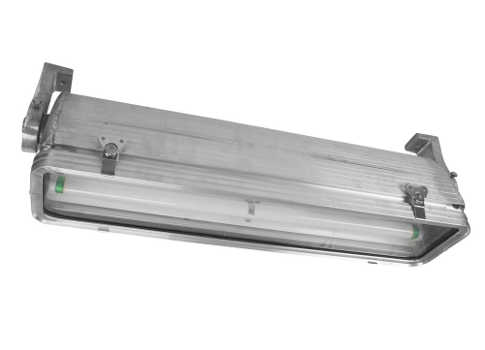First published in 1979, NFPA 70E, Standard for Electrical Safety in the Workplace, has evolved tremendously over the years. The standard offers 13 electrical safety standards every worker needs to know.

NFPA 70E insights
- It’s critical to create safe working conditions around electricity.
- Being a qualified electrical worker is important to safety.
- It’s crucial to understand what condition of maintenance means.
When it comes to electrical safety, the National Fire Protection Association’s (NFPA) 70E Standard for Electrical Safety in the Workplace is lengthy and informative. The current 2024 edition is 113 pages, three chapters and 19 Informative Annex sections.
Many sources of information and safety knowledge are embedded in these pages, but which ones should you really know the most about? Which parts are the most important?
1. Turn it off
Easily the most important requirement and aspect of NFPA 70E is quite simple: Turn it off!
Turning it off means to create an “electrically safe work condition” as defined in NFPA 70E Article 100 Definitions:
A state in which an electrical conductor or circuit part has been disconnected from the energized parts, locked/tagged in accordance with established standards, tested for the absence of voltage and, if necessary, temporarily grounded for personal protection.
Article 120, Establishing an Electrically Safe WorkCondition, provides guidance on what you need to know and provides step-by-step instructions on how to achieve a safe condition in which to work.
If you don’t do anything else, study and understand all the elements of Article 120. It might just save your life.

2. Live-Dead-Live
You might call this more of the first rule, and even though it’s part of the information in Article 120, make sure it’s off before starting work. It’s worth noting and repeating.
Absence of voltage must be verified through a three-step process, as stated in 120.6 Process for Establishing and Verifying an Electrically Safe Work Condition. How do you do this?
1. Check your voltage test instrument by applying it to a known source.
2. Check the conductor or circuit part you are about to work on.
3. Verify that your voltage detector still works by testing it a final time on a known source.
That’s the live-dead-live process. It’s critical to conduct this test every time.
Here’s a tip. After going through the process of establishing an electrically safe work condition, including locking it out, testing for the absence of voltage and temporarily grounded it for personal protection, step back and to the side, turn your head, and tap the bus or whatever you are about to work on with the back of your hand through your fingernails.
You’re about to work on it anyway and, if for some reason, something went wrong and the part was still energized, you might receive a shock or worse, but you won’t clamp down on the part, and you hopefully will survive the blast. Also, this is the point in your life when you might consider that career in accounting.

3. Be qualified
Only qualified electrical workers with the necessary training and experience should do electrical work, especially when working on or near energized electrical equipment. Even though employers are required to verify and document someone’s qualifications and ensure employees are properly trained and equipped with the correct personal protective equipment. Who is the best person to determine whether you are qualified? Well, look in the mirror, because that would be you.
If you are asked to do something that involves electrical equipment, make sure you completely understand the definition of a qualified person, found in Article 100 General Requirements for Electrical Safety-Related Work Practice, which states:
One who has demonstrated skills and knowledge related to the construction and operation of electrical equipment and installations and has received safety training to identify the hazards and reduce the associated risk.
Before you begin a task, ask yourself, “Am I qualified to do this?” If the answer is “No” or “I’m not sure,” then step back and reassess the situation. Don’t put yourself in harm’s way.
4. Lock it out/tag it out (LOTo)
This is part of establishing an electrically safe work condition, but it is such an important rule to follow every time you work on a piece of equipment.
Locking equipment or power sources in the off position is to prevent unintentional energization. It seems like a simple and reasonable thing to do, but it happens all the time. A worker doesn’t lock out a piece of equipment and gets hurt or killed.
The section 120.5 Lockout/Tagout Procedures is an excellent piece under Article 120. If you treat this section as a training and education guide for your personal use and understand it completely, not only will you be a safer worker, but you’ll also resonate as a leader to those around you. Treat it as energized until you know it’s not. Lock it out/tag it out.
5. Assess the risk
Always assess the risk before beginning any electrical work. Section 110.3(H) provides the essential elements of risk assessment, including:
- Key elements of the risk assessment procedure
- Potential for human error
- The hierarchy of risk control methods
Also refer toInformative Annex F Risk Assessment and Risk Control, which provides a wealth of information on the subject.

6. Know your boundaries
One of the most important aspects of electrical work is applying rules and actions about how close you can safely approach a piece of equipment without getting shocked or burned. You do this by performing an electric shock assessment, which is detailed in 130.4 Electric Shock Risk Assessment. This section details the electrical approach boundaries, including:
- Electric shock
- Limited approach
- Restricted approach
You’ll find that these are the minimum safe distances for both qualified and unqualified personnel to safely work on or approach energized electrical equipment. If the 70E’s rules related to these boundaries are followed, it will help protect employees from electrical shock and arc flash hazards. These are essential components of NFPA 70E and serve as a foundational element for creating a safer working environment.
7. Personal protective equipment (PPE) is a must
When it comes to your last line of defense — personal protective equipment (PPE) — you must read, understand and review 130.7 Personal and Other Protective Equipment. Within this section, you’ll find specifics for selecting and using appropriate PPE, including arc-rated clothing, face shields, gloves and other protective gear. It’s a very informative part of the standard — so know it well.
8. Plan your work
If you are a scuba diver, you have probably heard the phrase, “Plan your dive, dive your plan.” The same goes for electrical work: You should always have a safety plan before commencing work, even for the most (perceived) trivial tasks. In the process of formalizing your plan and reviewing your tasks, you will go through several key safety steps. You can find a wealth of information in 110.3(I) Job Safety Planning and Job Briefing. The key safety planning components are:
1. Completion by a qualified person
2. Documentation
3. Additional information:
a. Description of the job and tasks
b. Identification of the electrical hazards
c. An electric shock risk assessment
d. An arc flash risk assessment
e. Work procedures, special precautions, energy source control
4. Job briefings
5. What to do when there are changes in scope
Planning your tasks is essential. Be sure you always have a plan in place.
9. Understand the calculations
As an electrical worker, you should know the significance of an incident energy value of 1.2 calories per centimeter squared (1.2 cal/cm2) to our industry. Why is this important? Because according to 130.5(E)(1), this is the point at which an arc flash boundary begins.
What’s the significance? Incident energy is heat. Humans are extremely vulnerable when exposed to heat, especially at the temperatures that can be generated by electrical equipment. The experts agree that if you limit your incident energy exposure to 1.2 cal/cm2, you most likely can recover from the exposure. It should be noted that it might not be without serious injury or even hospitalization, but it should be survivable.
Wear PPE to limit your exposure to arc flash hazards. NFPA 70E gives guidance on two methods for risk control: 130.7(C)(15) Arc Flash PPE Category Method and 130.5(G) Incident Energy Analysis Method.
The arc flash PPE category method requires you to identify the maximum available fault current, the maximum fault-clearing times, and the minimum working distances for the type of equipment you are working on. This is done using one of two tables: Table 130.7(C)(15)(b) for dc systems or Table 130.7(C)(15)(a) for ac systems.
The incident energy analysis method requires a calculation to determine the arc flash boundary and specific incident energy values at a defined working distance. This is the information you will see on arc flash hazard warning labels. For more information, see Informative Annex D Incident Energy and Arc Flash Boundary Calculation Methods.
10. Low voltage is dangerous
Low voltage does not mean low danger. From someone who knows firsthand what a 480-volt transfer switch can do to you, know that low-voltage equipment — even 120-volt equipment — is dangerous and can kill you.
Section 110.2(B) directs you to place energized electrical conductors and circuit parts that are “operating at voltages equal to or greater than 50 volts” into an electrically safe work condition.
When you step back and think about it, why would a threshold of 50 volts be a point of demarcation in a safety standard? Because that’s the point at which you can experience severe injury or death. The message here is simple: Respect all levels of voltage you work on, whether it’s a 120-volt residential circuit or a 138-kV power transformer.
11. Know your equipment
Remember that the definition in Article 100 of a qualified person is someone who has “demonstrated skills and knowledge related to the construction and operation of electrical equipment.” This means you must understand what you are working on before you work on it.
Electrical equipment is dangerous. It can kill you. Knowing the construction, operation, clearances, key components, insulation methods, interlocks, indicators, sights, sounds, smells is all part of being qualified and knowing what you are doing.
Take the time to study and understand how something works before you work on it. Go slow, and if you don’t understand it, ask for help.
12. Maintenance is important
You should have a thorough understanding of the safety-related maintenance requirements in NFPA 70E, which can be found in Chapter 2 Safety-Related Maintenance Requirements. You should especially understand what “condition of maintenance” means, as electrical workers must be assured that equipment will operate as intended and as designed. Article 100 defines condition of maintenance as:
The state of the electrical equipment considering the manufacturers’ instructions, manufacturers’ recommendations and applicable industry codes, standards and recommended practices.
Section 130.5(B)(2) talks about arc flash risk assessment and the considerations you should take when estimating the likelihood and severity of injury or damage. It specifically states that you should consider the electrical equipment’s operating condition and the condition of maintenance.
The condition of maintenance directly impacts system performance, reliability and, most importantly, the safety of those working on or near the equipment. We are seeing an increased awareness in the industry regarding maintenance and how the significance of proper electrical maintenance plays to the overall safety of personnel and equipment.
13. Have fun
While it’s not specifically addressed in NFPA 70E, enjoying your work is important to your overall health and safety. If you enjoy what you do and go about your day with a good attitude, you will be more likely to:
- Engage in continuous learning and hone your skills
- Lead others through your experiences and demonstrate your skills
- Reduce your stress levels, enhancing productivity
- Work better as a team player
- Increase your creativity and problem-solving skills
- Be more productive, which translates to working safer
- Make the customer feel better, so if momma is happy, everyone is happy
- Manage the whole work-life balance aspect of your soul
Enjoy your job, learn about these important aspects of NFPA 70E, have fun –– and do so safely.



